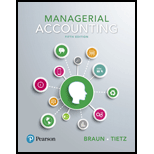
Budgeting for a Single Product
In this activity, you will be creating budgets for a single product for each of the months in an upcoming quarter. Select a product that you could purchase in large quantities (at a Sam’s Club or other warehouse retail chain) and repackage into smaller quantities to offer for sale at a sidewalk cafe, a sporting event, a flea market, or other similar venue. Investigate the price and quantity at which this product is available at the warehouse. Choose a selling price for the smaller (repackaged) package. Make reasonable assumptions about how many of the smaller units you can sell in each of the next four months (you will need the fourth month’s sales in units for the operating budgets).
Basic Discussion Questions
- 1. Describe your product. What is your cost of this product? What size (quantity) will you purchase? At what price will you sell your repackaged product? Make projections of your sales in units in each of the upcoming three months.
- 2. Estimate how many hours you will spend in each of the upcoming three months doing the purchasing, repackaging, and selling. Select a reasonable wage rate for yourself. What will your total labor costs be in each of the upcoming three months?
- 3. Prepare a sales budget for each of the upcoming three months.
- 4. Prepare the direct material budgets for the upcoming three months, assuming that you need to keep 10% of the direct materials needed for next month’s sales on hand at the end of each month (this requirement is why you needed to estimate unit sales for four months).
- 5. Prepare a direct labor budget (for your labor) for each of the upcoming three months.
- 6. Think about any other expenses you are likely to have (i.e., booth rental at a flea market or a vendor license). Prepare the operating expenses budget for each of the upcoming three months.
- 7. Prepare a
budgeted income statement that reflects the budgets you prepared, including the sales budget, direct materials budget, direct labor budget, and the operating expenses budget. This budgeted income statement should include one column for each of the three months in the quarter, and it should also include a total column that represents the totals of the three months. What is your projected profit by month and for the quarter?
Want to see the full answer?
Check out a sample textbook solution
Chapter 9 Solutions
Managerial Accounting, Student Value Edition (5th Edition)
 Cornerstones of Cost Management (Cornerstones Ser...AccountingISBN:9781305970663Author:Don R. Hansen, Maryanne M. MowenPublisher:Cengage Learning
Cornerstones of Cost Management (Cornerstones Ser...AccountingISBN:9781305970663Author:Don R. Hansen, Maryanne M. MowenPublisher:Cengage Learning Excel Applications for Accounting PrinciplesAccountingISBN:9781111581565Author:Gaylord N. SmithPublisher:Cengage Learning
Excel Applications for Accounting PrinciplesAccountingISBN:9781111581565Author:Gaylord N. SmithPublisher:Cengage Learning Managerial Accounting: The Cornerstone of Busines...AccountingISBN:9781337115773Author:Maryanne M. Mowen, Don R. Hansen, Dan L. HeitgerPublisher:Cengage Learning
Managerial Accounting: The Cornerstone of Busines...AccountingISBN:9781337115773Author:Maryanne M. Mowen, Don R. Hansen, Dan L. HeitgerPublisher:Cengage Learning Managerial AccountingAccountingISBN:9781337912020Author:Carl Warren, Ph.d. Cma William B. TaylerPublisher:South-Western College Pub
Managerial AccountingAccountingISBN:9781337912020Author:Carl Warren, Ph.d. Cma William B. TaylerPublisher:South-Western College Pub



